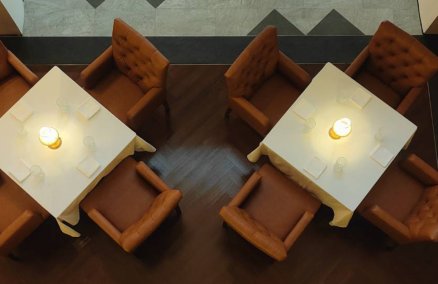[Sponsored] Japanese sake has been a small but strong trend among Singapore’s more discerning diners—those who know all about the unique delights of places like Orihara Shoten, Kakure and, most recently, the exciting six-month pop-up by the renowned sake brewery Dassai, in Wisma Atria’s Japan Food Town.
If you’ve always wanted to learn more about the unique delights of Japanese rice wine, you’ll have to start with the label. Almost entirely in Japanese, sake bottles can be bewildering for the Singaporean fan. Not to worry—we have this handy diagram and some helpful tips from sake sommeliers to get you started.
Reading the Bottle
As with wine, the sake label has lots of crucial information. Here’s what to look for.
1. Company seal. This is the name of the brewery or producer, as well as their address.
2. Name of the sake. This is usually different from the name of the producer, though sometimes it might be the same.
3. Type of sake. This one says “super dry”. Other labels may indicate here if it is a premium sake, and if so, which one in particular. This information is sometimes also indicated in English.
4. Special Ingredients. Sake is normally made with rice, yeast, water and koji (mold spores). If there are any other ingredients added, such as malt (tokubetsu), there will be a special symbol here.
5. Date of production. In general, sake is best consumed within two to three months of production and within a couple days of being opened.
6. Types of sake
There are seemingly endless varieties of sake, but experts tend to break it down into five main types. An important distinction here is the seimaibuai of the rice being used. (For more on this, see #7.)
Daiginjo (大吟醸) has a seimaibuai of roughly 50%. These are usually sweet, aromatic and natural tasting, and are recommended for beginners as they’re easy to drink.
Ginjo (吟醸) has a seimaibuai of at least 60% and has additional alcohol added. It’s similar to daiginjo—fruity, light and aromatic.
Junmai (純米) is pure sake—brewed with nothing but rice, water, yeast and koji. With its strong, not-so-sweet taste, it’s suitable for hardcore sake fans. The seimaibuai varies but is mostly around 70%. Many bottles are labeled junmai ginjo, which means pure sake with 60% seimaibuai.
Nama ( 生) is unpasteurized sake with a more intense flavor. It’s fresher and more aromatic but the quality is less stable.
Honjozo (本醸) is sake brewed with seimaibuai of at least 70%, with distilled alcohol added.
7. Seimaibui. Rice is milled or “polished” before being used in brewing to eliminate fat, protein, and minerals that can inhibit fermentation. The percentage on the bottle represents the amount of the original rice grain that remains after polishing. Generally, the more the rice is polished, the more refined the sake’s flavour. That is to say, the lower the seimaibui percentage the better.
8. Alcohol Content. Boozier than wines, sake’s alcohol content ranges from 15-20%.
9. Drinking Suggestion. The label gives a recommendation on how the sake is best consumed (most ranked from cold to hot): at room temperature, with ice or hot. A recommendation with two circles is advice you really should follow, while one circle is not as highly suggested.
Plenty more where that came from. The Bite! Japan Facebook page is full of the latest Japanese restaurants and izakaya in Singapore, new promotions and bits of information to impressive your friends with. Follow us here.
Hear From the Experts

Kazuhiro Sakurai, President and Fourth-Generation owner of Dassai Brewery
From a sake point of view, how would you describe Singapore right now?
I think the Singapore market is going to be very good, especially for the high-end Japanese sake. Many high-end Japanese restaurants have opened in the past couple years, and they carry high-end sake, like Ginjo and Daiginjo styles. And as you know, Singapore has many foreigners who visit and dine at these restaurants. So not only is the Singaporean market itself very strong, it also acts as a showcase for the world.
What are some tips for choosing sake to suit the occasion?
There aren’t as many difficult pairing rules in sake, unlike in the wine world. Simply, try heavy food with heavy sake, and light foods with light sake. Also, sake goes very well with seafood and vegetables.
What’s unique about Dassai sake?
We are focused on the premium Junmai-Daiginjo sake category, made with the best sake rice grain, Yamada-Nishiki. This makes us specialists of fruity and clear-tasting sake.

Makoto Iwabuchi, Sake Sommelier, Ki-Sho
What’s a common question you get from customers?
They’d like to know how long a sake can be kept, especially very expensive sake. Generally sake cannot be kept as long as wine.
What’s a sake and food pairing you love?
I recommend aged or Junmai sake with a hard cheese.
How are wine and sake cultures different?
People seem to think that that wine is a drink that goes with food and are always looking for the best pairing. When it comes to sake, people don’t yet think much about pairing it with food.
What is the state of sake appreciation in Singapore at the moment?
My guests are no longer beginners. They can choose their favorite sake already, name their favorite style of sake. They even know about their preferred temperature and glasses. They’re at the next level.
Like what you see? For regular updates on Japanese food and drink in Singapore, follow Bite! Japan on Facebook.
| This post is brought to you by |  |
Advertisement















